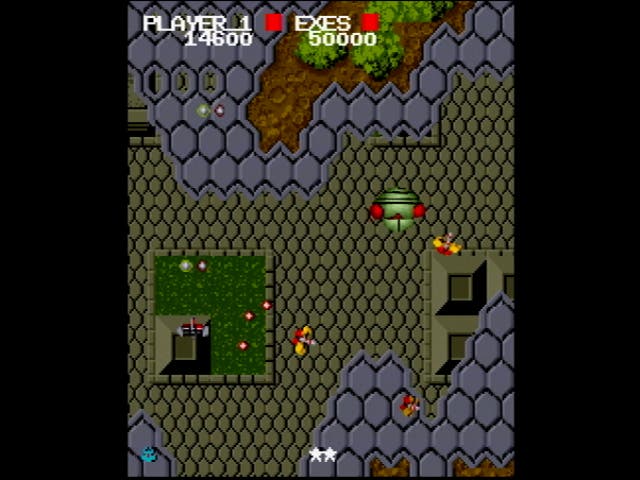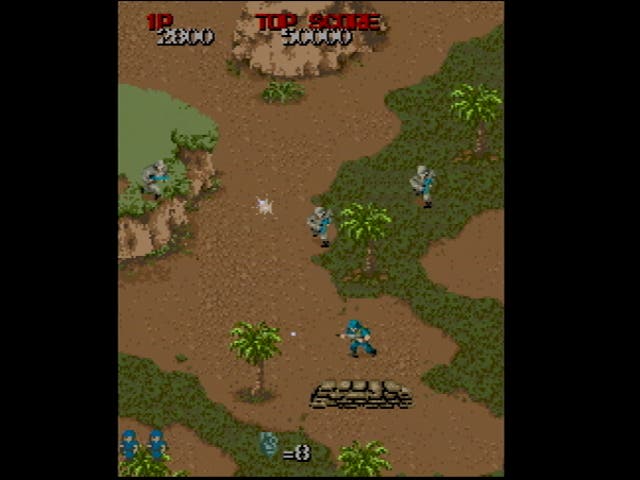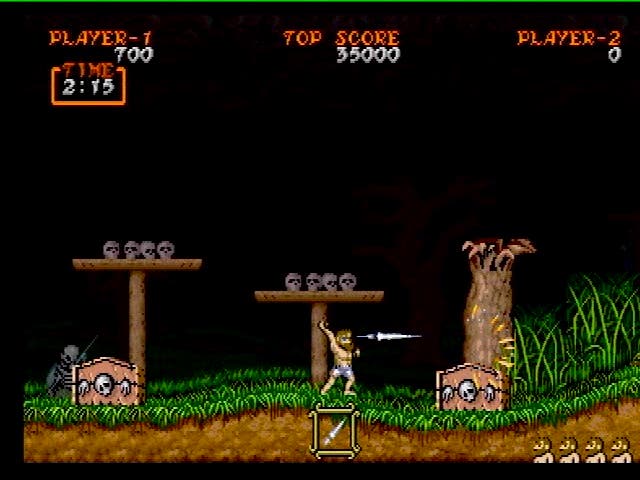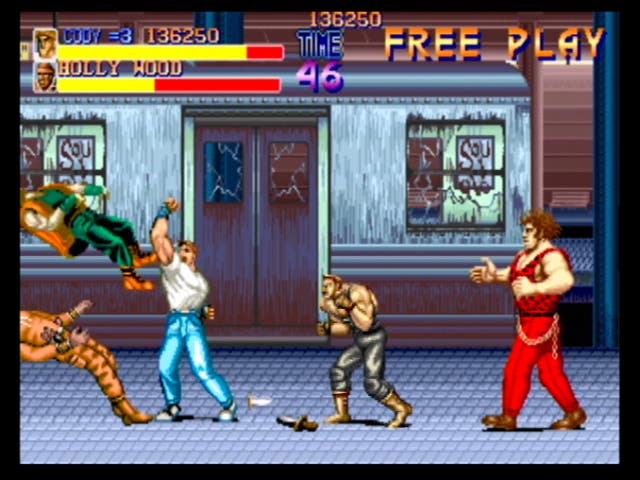Capcom Classics Collection
Pay your respects to the Japanese legends.
It's an odd situation when the very idea of a retro compilation seems so... retro. It's already nine and a half years since we started messing around with emulators like MAME (anyone remember the original Capcom one called Callus?), and roughly the same amount of time since the Namo Museum release. So, after about four or five years of wallowing in all manner of nostalgia we kind of got it out of our system. The thing that was most surprising about relentlessly playing all these old arcade games from the 80s and early 90s wasn't how much they'd aged or how rock hard they could be, but how much derivative me-too stuff was around even then. The best lesson for us back then was not to bandy the word 'classic' around too much. Not all retro games are born equal, and just because a game is 21 years old, it doesn't mean it deserve to be deemed a 'classic'.
Just to make sure that enough 'classics' are on this compilation, Capcom's stuffed an almighty 22 games into its first all-encompassing retro package (the previous Capcom Generations package on PS1 being decidedly slim in scope), spanning 1984 to 1992. Probably only a quarter of them are real bona-fide must-haves that still entertain to the same degree that they did back then, but arguing the merits of games that each and every one of us will have differing levels of attachment to is rather futile. Rational discussions go out of the window when it comes to old games - sometimes we liked them because it was the one that our local chippy had, or we remember a sexy lass being impressed with our high-score (or something).
But let's try and remove emotional, hormonal, nostalgia-tinged memories from the games in question for a moment and suss out whether they're really likely to entertain you in this day and age.
The early-Z80 years

Kicking off with Vulgus, this straightforward vertical-scrolling shooter was a solid debut offering from Capcom, but gave no hint to the greatness to come, and was only released in Japan. Although it's a perfectly playable Xevious clone, its me-too approach does little to mark it out as anything special. The one-hit-death mechanics and lack of weapon power-ups and no continues made it tough going back then - never mind now! Son Son was Capcom's first US release back in '84, and its charming combination of horizontal side-scrolling platforming and shooting was quite unique at the time. Even now, there are few games we can think of that were anything like this (Jumping Jack on the Spectrum at a push), and as a curiosity it's a great little game to pick up and play, with a two-player co-op mode giving a hint of the direction to come. Released later the same year, Pirate Ship Higemaru is a real lost gem that's instantly addictive, and appeals to the wide-eyed 11 year-old in us. Drawing heavy inspiration from the likes of Pengu, the idea is to launch barrels (instead of blocks of ice) at the pirates that run around the maze-like confines of a ship. A perfect example of how utterly simplistic gameplay can still appeal today.
Capcom's first title to gain mass recognition was 1942 (largely thanks to the Elite conversion released on various 8-bit platforms), a thinly-veiled World War II take on Namco's Galaga/Gaplus lineage. Even at the time it felt pretty derivative, with literally dozens of vertical-scrolling shooters being released at roughly the same time. The inclusion of the then-new concept of continues made it possible to wade through the 32 stages, but although it's a solid genre offering, only blind nostalgia could persuade us to want to play this for more than a quick run-through. At this point, Capcom clearly figured that it could milk the vertical shooter genre a little more, and the release of the sci-fi-tinged Exed Exes (Savage Bees in Europe) was evidently 1942 with insects, and just as solid yet underwhelming. Its re-release on this compilation makes for an interesting history lesson, but it's no classic. Next up in 1985 was the awesomely-successful Commando, another title that made a big splash on 8-bit home systems. Using an isometric viewpoint, it looked absolutely stunning at the time, and was an excellent example of 'one man against an entire army' gameplay that continues to this very day. Hard as nails now, though, with one-hit-death gameplay and no continues making it exceptionally tough going. Sure to have many people's nostalgia glands working overtime.
Into the groove: 1985 to 1987

By now, well into the groove of vertical-scrolling shooters, 1985's Gun Smoke took the Commando concept and shoe-horned in into a Wild West setting. With a multidirectional fire system (possible via button combos) it was possible to fire in six directions, but somehow lost some of the instant appeal of Commandos in the process. Continues and two-player co-op sweeten the pill, and make it a charming curiosity offering, but it's no classic. Released the same year, Ghosts n' Goblins was most definitely an instant classic, combining the standard side-scrolling platforming premise with boundary-breaking visuals (easily five years ahead of their time in terms of home systems), a charming premise, numerous challenging enemies, a variety of weapons and the kind of jolly ditty that lodges itself in your brain forever. Treading a fine line between addictive and challenging, it later became another huge hit for Elite the following year on every 8-bit platform going. A classic even now. The Z80-based Section Z, however, is a standard horizontal shooter that tasks your Jetpac-equipped man with clearing corridors of a spacecraft. Quite typical of games of this era, with power-ups and continues helping you along and definitely a solid genre offering - but you'll find it hard to get enthusiastic about it now.
By 1986, Capcom was still keen on milking the vertical shooter genre a little more, but Legendary Wings went a little further by adding horizontal side-scrolling platforming-shooting interludes between the standard shooting gameplay. With two-player co-op and continues now part of the furniture, you could feasibly power through the game with persistence, but the one-touch-death mechanics still make it an unforgiving git of a shooter to try and go back to now. A typical genre offering, and by no means worthy of classic status. Trojan is now deemed a 'precursor to Street Fighter' according to Capcom, but in truth, this side-scrolling fighter feels more like a cross between Ghosts n' Goblins and the seminal Final Fight, bringing that hack and slash combat and GnG visuals to the arcade. Nothing special, though, and unless you've got special memories of this one locked away, you'll mark this one down as a curiosity offering only.
Wrapping up its enduring use of Z80 technology and continuing its love-affair with the vertical shooter, 1943 and its companion release 1943 Kai (released only in Japan the following year), these follow-ups to 1942 threw in the gameplay innovations of the time, such as health bars (goodbye one-touch-death, how we hated you), continues, special screen clearing attacks, improved visuals, improved speed and two-player co-op gameplay. Still feels fun today, although the Kai version is just ridiculously hard work and has the funniest arcade music of all-time. Jazz midi, indeed. The only title on this compilation to use the 6800-based arcade board, Bionic Commando was a unique multi-scrolling platform, featuring the same 'Super Joe' character in Commando. This time, though, you have a grappling hook weapon to allow you to leap between platforms, swing around and bash up the enemy. Amazingly, this isn't as good as the home versions, but it's still worth a crack, just for the ace theme tune.
1988-1992: The Capcom Play System years

Forgotten Worlds kicked-off Capcom's brave new era of proprietary arcade technology, using its CPS (Capcom Play System) boards for the very first time. Although insignificant to our eyes now, at the time it catapulted Capcom's ambition skywards, with bolder visuals, far bigger sprites and richer backgrounds. This side-scrolling shooter wasn't perhaps the best example of that, being little more than a solid genre offering with the benefit of hindsight. Stripped of the rotary fire joystick, the game can't really be emulated properly here, so it's unfair to dismiss it completely, but it's no classic. Ghouls 'n Ghosts, though, still feels worthy of acclaim, and manages to live up to its reputation as one of the best platformers of the 1980s. With ahead-of-their time visuals (again), and some superbly designed levels, it's one of those games that brings a smile to your face even now. Tough, but worth it.
1989's Final Fight definitely lives up to its legendary status as a seminal brawler, despite the hilarious lack of animation. The simple move set, co-op gameplay and bold graphics mark it out as an enduring title that's every bit as fun and charming as it was back in the days when shoulder pads and big hair was king. Although things have moved on massively since then, there's something about FF that appeals to the inner child in us. You'd have to be made of stone to not enjoy this one. Definite classic, no question. The oft-overlooked Mercs (from 1990) returned to the Commando franchise and overhauled the concept with two-player co-op gameplay, a health bar system, weapon and food pick-ups and upped the enemy count to vast proportions. Perhaps a little too frantic for its own good (it's as if the designers wanted to show off the hardware more than designing a playable, balanced game), it's still a good blast, especially in multiplayer, but doesn't quite have the instant charm of the original. The addition of 1991's Super Ghouls 'n Ghosts is definitely welcome, as it's another excellent offering in the classic series, but it's an anomaly in that it's the only non-arcade title here, being originally a SNES title. Once again it follows the exact same formula as before, with multi-directional platform combat fun, but with - wait for it - a double jump! Such things were important in 1991.
And wrapping up this epic compilation are the three Street Fighter II titles, which for some of you will be the stars of the show. The original 1991 'World Warrior' version featured just eight playable characters (nothing compared to today's ever-expanding versions), but still represents a true classic. Real aficionados have noted some bizarre tweaks (why the loading pauses, for instance?), changes, and audio glitches and complain that the feel isn't quite what it should be, so approach with a certain degree of caution. The further addition of the Champion Edition (adds the four bosses of the previous version) and the fast and furious Hyper Fighting edition will add a little more spice for those of you seeking out specific classic versions, but there are numerous Street Fighter collections that arguably round up this particular corner of the retro gaming market better. Still, for the price, you really can't argue with the value this package represents.

Compared to some of the miserly retro collections we've seen lately (Tecmo and Midway 3 to name but two), you certainly can't argue with the depth of Capcom's first commercial retro collection. Digital Eclipse definitely deserves credit for not just lovelessly porting everything. For instance, each game has a decent amount of background info, tweakable game settings (that can be saved along with the high scores) and a plethora of unlockable extras that can be gained from repeat play - a unique touch that's very welcome. It's by no means a complete set of what Capcom was up to during this period, though, with several notable hits missing (such as Strider, Megaman and the original Street Fighter, for example) - but we fully expect a follow-up that fills in the gaps at a later date.
With some retailers pricing this at around the £14.99 mark, it's hard to resist such a great value compilation, even if there are only about a handful of real nailed-on classics in the 22-game set. For those of you that haven't been down the MAME route and are revisiting some of these games for the first time in 15, 20 years, you'll be surprised just how enduring some of them still are - particularly Ghouls 'n Ghosts, Commando, and, of course, the legendary Street Fighter. The majority, though, have to be viewed with a certain degree of retro sympathy and serve as a timely reminder of just how far we've come in a short space of time. For nostaligists or gaming historians it's definitely worth every penny, and gives a startling insight into the genesis of one of the greatest gaming companies of all time. Capcom, we salute you.

